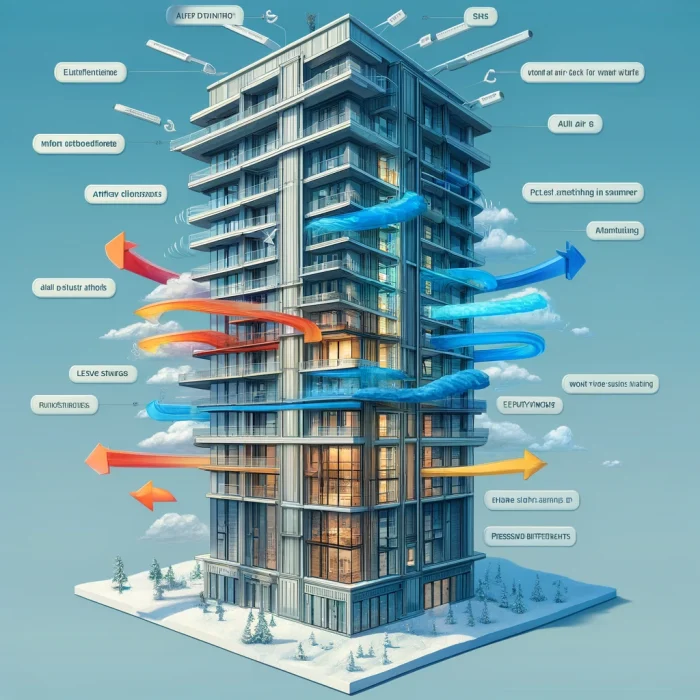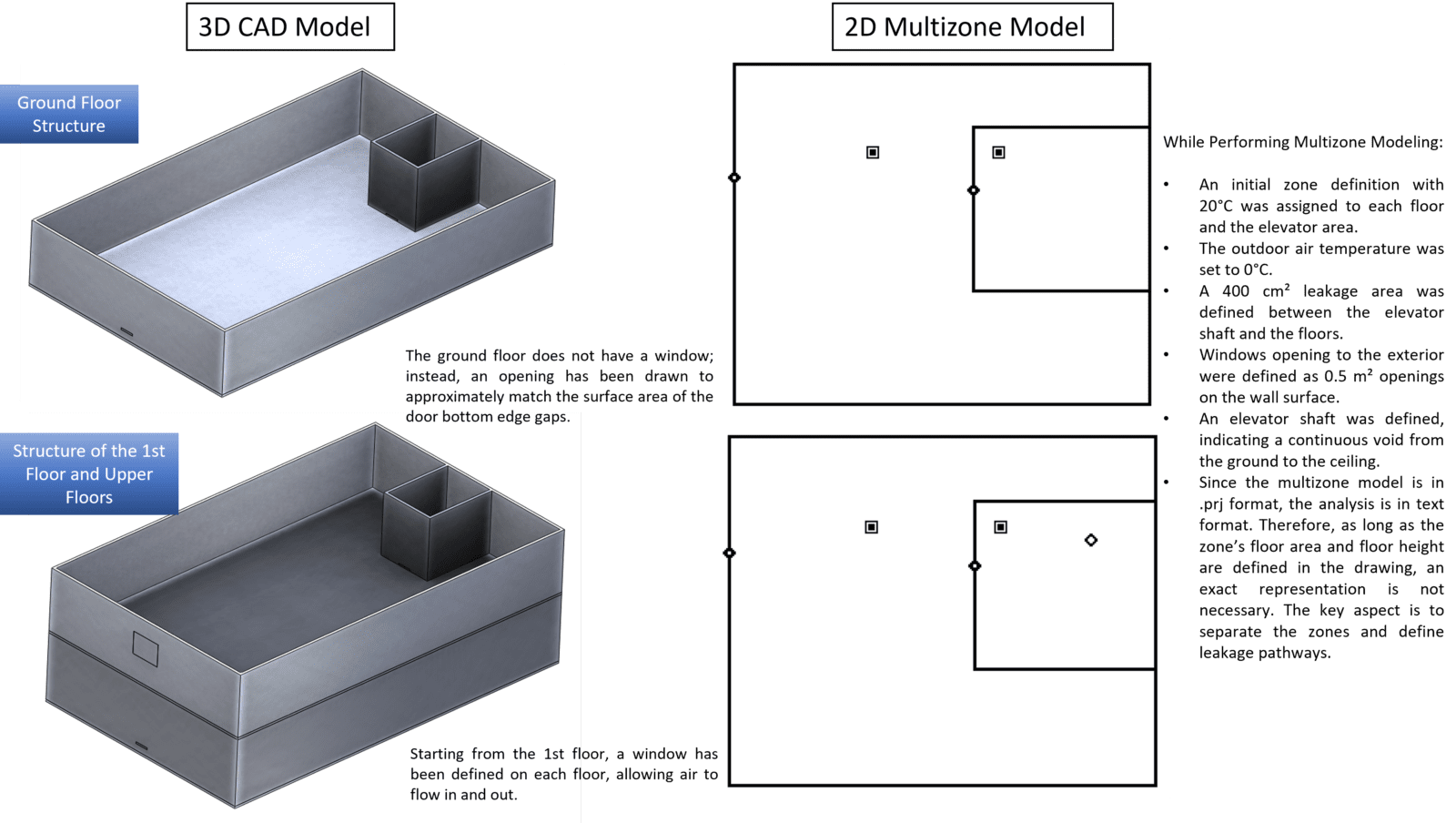
Advanced Analysis of Stack Effect: Comparison of Multizone (Zone) Model and CFD
In our previous article, we discussed the concept of the stack effect and its significant impacts on high-rise buildings. This time, we will delve a bit deeper into the subject by examining the results of “multizone (zone) model” analyses conducted on the same building and comparing these results with those obtained through CFD (Computational Fluid Dynamics) analyses. This comprehensive approach provides an opportunity to explore why and how airflow should be controlled in buildings.
1. A Brief Reminder on the Stack Effect
The stack effect is a natural air movement caused by temperature and density differences between the interior and exterior environments. This effect is more pronounced in high-rise buildings and is characterized by the following basic dynamics:
- During Winter: When the inside of the building is warmer than the outside, warm air tends to rise toward the upper floors and escape through openings near the ceiling. On the lower floors, the resulting negative pressure can draw cold outside air inside.
- During Summer: The situation may reverse. If the exterior is warmer than the interior, warm air can infiltrate inside while cold air moves downward, tending to exit from the lower floors.
When not controlled, this airflow can lead to numerous adverse effects, such as comfort issues, pressure problems at doors and windows, acoustic disturbances, and rapid spread of fire and smoke. Therefore, calculating and controlling the stack effect is of vital importance in engineering projects.

2. What is a Multizone (Zone) Model?
A multizone model is an approach that represents different sections (zones) of a building with simple flow connections, allowing for relatively fast and practical calculations. Each floor or section is defined as a “zone.” The leakage, air inflow-outflow openings, and pressure differences in areas such as doors, windows, and shafts between these zones are mathematically expressed in the model.
2.1. Why Use a Multizone Model?
- Rapid Simulation: It delivers results in a much shorter time compared to complex CFD models.
- Suitable for Early Design Phases: It is ideal for quickly testing various scenarios and forecasting the overall behavior of the system during the early stages of design.
- Requires Less Detail: Working with basic parameters like floor heights and leakage areas is sufficient, without dealing with three-dimensional geometries.
3. Comparison with CFD Analysis
CFD (Computational Fluid Dynamics) analysis enables us to calculate the three-dimensional movement of air (fluid flow) and the distribution of velocity, pressure, and temperature at every point in detail. Although this method is more realistic, it demands considerably more effort and resources at many stages, from model setup to calculation time.
In our study, we performed both a multizone model and a CFD-based simulation for the same building. The basic assumptions used were as follows:
- Interior Condition: Each floor and elevator area was initially set at 20°C.
- Exterior Condition: In the winter scenario, it was set at 0°C.
- Elevator Shaft Leakage: A leakage area of 400 cm² was assumed between the floors and the elevator shaft.
- Window Openings: An opening of 0.5 m² was defined on the exterior for each floor (the ground floor was considered to have a similar leakage area as the gap under the door).
- Model Format: The multizone model includes text-based definitions (in .prj format), while the CFD side involved creating a three-dimensional geometry and a detailed mesh.
4. Analysis Results: Pressure Differences and NPL (Neutral Pressure Level)
In buildings, the “Neutral Pressure Level (NPL)” refers to the floor where the interior and exterior pressures are equal. This level is critical because it indicates the height at which the stack effect neutralizes the pressure differences.
Multizone Model Results:
- Average pressure difference between the ground floor and the elevator shaft/room: 16.4 Pa
- Average pressure difference at the NPL floor: 0.4 Pa
- Average pressure difference at the top floor: 30.4 Pa
CFD Analysis Results:
- Average pressure difference between the ground floor and the elevator shaft/room: 16 Pa
- Average pressure difference at the NPL floor: 0.1 Pa
- Average pressure difference at the top floor: 32.2 Pa

5. Evaluation of the Results
- Location of the NPL: In both models, the NPL is observed near the upper floors of the building. In a windless winter scenario, the NPL is positioned around the 13th-14th floor, but its level may shift upward or downward under the influence of wind.
- Pressure Differences: Small discrepancies between CFD and multizone models are normal. CFD captures local effects and turbulence in more detail, so the numerical results may slightly differ from those of the multizone model.
- Control Measures:
- Pressure loads on elevator doors (25 Pa and above) can affect their opening and closing performance.
- Revolving doors can withstand pressures up to approximately 130 Pa, but pressures approaching these levels should be carefully evaluated for comfort and safety.
- Accurately calculating the leakage areas of windows and doors during construction is critical for controlling the stack effect.

6. Tips for Managing the Stack Effect
- Early Stage Modeling: Conducting both rapid multizone analyses and, when necessary, CFD analyses during the project phase in high-rise buildings can prevent potential issues later on.
- Pressure Equalization Strategies: Methods such as under-door leakage, controlled air intakes, inter-floor curtains, or air curtains can reduce unwanted pressure differences.
- Fire and Smoke Control: The stack effect can cause rapid spread of smoke during a fire. It is essential to design appropriate smoke control systems during both the project and operation phases.
- Periodic Maintenance: Observing airflow patterns that vary between winter and summer, and periodically inspecting ventilation and pressure balancing equipment, is crucial.
7. Conclusion
The stack effect, one of the most critical factors affecting airflow in buildings, can reach significantly serious dimensions in high-rise structures. Multizone (zone) model analyses offer quick and practical insights into estimating this effect and determining pressure differences, while CFD provides detailed local data. By combining both approaches, it is possible to achieve more realistic results while saving both time and costs.



